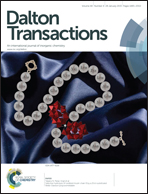Varying coordination modes of amide ligand in group 12 Hg(ii) and Cd(ii) complexes: synthesis, crystal structure and nonlinear optical properties†
Abstract
Reactions of the amide ligand, H2L (H2L = N,N′-bis[2-(2-pyridyl)methyl]pyridine-2,6-dicarboxamide) with CdCl2 and Hg(CH3COO)2, in 1 : 1 ratio, at 298 K yield dimeric [Hg(L)]2 (1) and trimeric [Cd3(H2L)4Cl6] (2), respectively. In 1, the H2L is coordinated to Hg(II) via six N-atoms of central and terminal pyridines as well as of deprotonated amido groups, whereas the carbonyl groups remain free. However, in 2, the H2L is coordinated to Cd(II) through terminal pyridine N atoms and O atoms from carbonyl groups, whereas the nitrogen atoms of the central pyridine, two terminal pyridine and of all amido groups remain free. Molecular structures of 1 and 2 are confirmed by single crystal X-ray studies. The varying coordination modes of H2L give rise to different electrochemical behavior of 1 and 2, which has also been rationalized by theoretical calculations. Moreover, nonlinear optical (NLO) behavior of both complexes has been investigated using ultra-short femtosecond laser pulses, which ensures that the NLO response is exclusively from their electronic component.


 Please wait while we load your content...
Please wait while we load your content...